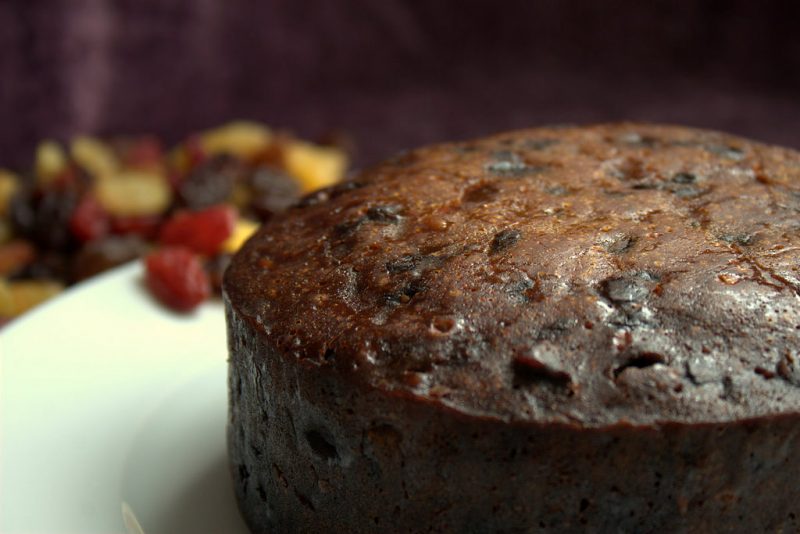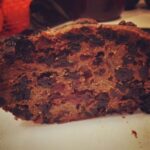
Victorian Christmas Cake
Full of fruits and spices, and perhaps lots of brandy, a scratch-made Victorian Christmas cake was a great way to show off wealth.
Ingredients
- 525 g 3 ½ cups currants
- 225 g 1 ½ cups golden raisins/sultanas
- 225 g 1 ½ cups raisins
- 110 g 3/4 cup mixed candied peel, finely chopped (make your own, using this easy recipe)
- 165 1 cup glace cherries, halved
- 300 g 3 1/3 cups plain flour
- Pinch salt
- 1/4 level teaspoon ground cloves
- 1/4 level teaspoon ground allspice
- ½ level teaspoon ground cinnamon
- ½ level teaspoon freshly ground nutmeg
- 300 g 10 oz butter, slightly softened
- 300 g 1 1/3 cups soft brown sugar
- Zest of ½ lemon
- 6 large eggs lightly beaten
- 3 tablespoon brandy plus extra for feeding
Instructions
- Heat the oven to 150C/300F/Gas 2
- The temperature is low as the cake needs a long slow bake. It is packed with sugars, fruits and brandy and if the temperature is any higher the outside of the cake will burn and the inside be undercooked.
- Line a 23cm (9″) cake tin with 2 thicknesses of parchment. Tie a double band of brown or newspaper paper around the outside. This acts as an insulator and to prevent the cake from burning.
- In a large roomy baking bowl mix the currants, sultanas, raisins, peel and cherries with the flour, salt and spices.
- In another large bowl cream the butter with the sugar until light and fluffy. Stir in the lemon zest. Add the beaten egg to the butter mixture a little bit at a time, beating well after each addition – do not try to rush this process as the mixture could curdle. If it does curdle simply add a tbsp of flour and mix again, this should bring the mixture back together. If it doesn’t come back together, don’t fret, the cake will still be delicious.
- Carefully fold in half the flour and fruit into the egg and butter mixture, once incorporated repeat with the remaining flour and fruit. Finally add the brandy.
- Spoon the cake mixture into the prepared cake tin making sure there are no air pockets. Once filled smooth the surface with the back of s spoon and make a slight dip in the center (this will rise back up again during cooking and create a smooth surface for icing the cake).
- Finally, using a piece of paper towel clean up any smears of cake batter on the parchment wrapping, if left on they will burn, and though it won’t affect the cake, it doesn’t smell too good.
- Stand the tin on a double layer of newspaper in the lower part of the oven and bake for 4½ hours. If the cake is browning too rapidly, cover the tin with a double layer of parchment paper after 2½ hours. During the cooking time avoid opening the oven door too often as this may cause the cake to collapse.
 After 4½ hours check the cake is cooked. The cake should be nicely risen and a deep brown all over. Insert a skewer or fine knife into the centre of the cake. If there is sticky dough on the skewer when you pull it out it needs cooking longer, if it is clean, the cake’s done and remove from the oven.
After 4½ hours check the cake is cooked. The cake should be nicely risen and a deep brown all over. Insert a skewer or fine knife into the centre of the cake. If there is sticky dough on the skewer when you pull it out it needs cooking longer, if it is clean, the cake’s done and remove from the oven.- Leave the cake to cool in the tin on a wire rack for an hour, then remove from the tin and leave to cool completely. Once cooled prick the surface of the cake with a fine metal skewer and slowly pour over 2 – 3 tbsp brandy. This feeding should be repeated every two weeks up until Christmas. The cake should be stored wrapped in parchment paper in an airtight tin.
Notes
Original recipe source: Elaine Lemm, although we’ve made a few adjustments.


 After 4½ hours check the cake is cooked. The cake should be nicely risen and a deep brown all over. Insert a skewer or fine knife into the centre of the cake. If there is sticky dough on the skewer when you pull it out it needs cooking longer, if it is clean, the cake’s done and remove from the oven.
After 4½ hours check the cake is cooked. The cake should be nicely risen and a deep brown all over. Insert a skewer or fine knife into the centre of the cake. If there is sticky dough on the skewer when you pull it out it needs cooking longer, if it is clean, the cake’s done and remove from the oven.